
Wolf spiders are members of the family Lycosidae, named for their robust and agile hunting skills and excellent eyesight. They live mostly in solitude, hunt alone, and usually do not spin webs. Some are opportunistic hunters, pouncing upon prey as they find it or chasing it over short distances; others wait for passing prey in or near the mouth of a burrow. Wolf spiders resemble nursery web spiders, but wolf spiders carry their egg sacs by attaching them to their spinnerets, while the Pisauridae carry their egg sacs with their chelicerae and pedipalps. Two of the wolf spider's eight eyes are large and prominent; this distinguishes them from nursery web spiders, whose eyes are all of roughly equal size. This can also help distinguish them from the similar-looking grass spiders.
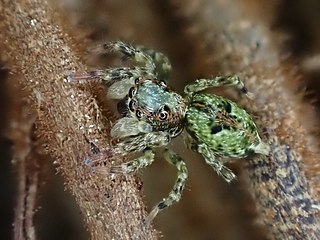
Hinewaia is a genus of the jumping spiders found in New Zealand. Its single described species is Hinewaia embolica.
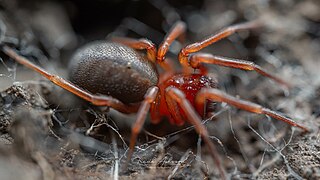
Periegops is a genus of spiders with six eyes instead of the usual eight. It is the only genus in its family (Periegopidae) and has three described species. It was long considered to be a member of Sicariidae or Segestriidae until Raymond Forster elevated it to the family level in 1995.

The Artoriinae are a subfamily of wolf spiders. The monophyly of the subfamily has been confirmed in a molecular phylogenetic study, although the relationships among the subfamilies was shown to be less certain.
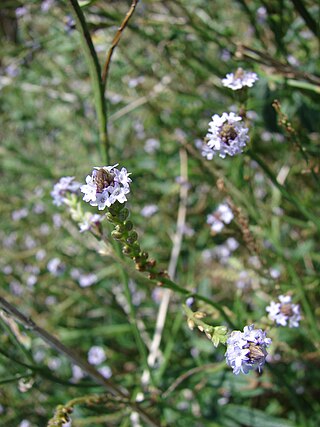
Verbena litoralis is a species of verbena known by the common names seashore vervain and Brazilian vervain, and in Hawaiian, ōwī. It is native to the Americas from Mexico south through Central and South America to Argentina and Chile. It is present throughout the world as an introduced species and in some areas a noxious weed. It is naturalized in the contiguous United States, Puerto Rico, Hawaii, Italy, Spain, South Africa, Mauritius, the Galápagos Islands, Australia, Easter Island, French Polynesia, Japan, New Zealand, and other places. It grows in many types of habitat, including disturbed and cultivated areas.

Cambridgea is a spider genus in the family Desidae and some of the first endemic spiders described from New Zealand. They are known for constructing large horizontal sheet webs measuring up to a square metre in larger species. Cambridgea were originally assigned to the Agelenidae by Dalmas in 1917 but were reassigned to the Stiphidiidae in 1973. Most recently, both Cambridgea and sister genus Nanocambridgea were reassigned to the Desidae, subfamily Porteriinae on the basis of molecular evidence.

Socca pustulosa is a Orb-weaver spider species in the family Araneidae, and it was first described by a French scientist Charles Athanase Walckenaer in 1841 from Tasmania, Australia, but later on when Walckenaer examined the specimen collected from New Zealand and renamed it as a different species- Epeira verrucosa. Until 1917, Dalmas reviewed the Australian pustulosa and New Zealand verrucosa and realized they were the same species. Although S. pustulosa has been accepted for some time in the genus of Eriophora, the evidence supporting its placement within this genus were not fully convincing. Therefore, an alternative view was proposed in 2022- a new genus established to accommodate pustulosa along with 11 other spider species from Australia; the diagnostic test based on haplotype analysis and systematic morphology study by arachnologists and found the anatomical features of male pedipalp terminal apophysis differs from other orb-web species.

Anoteropsis is a genus of wolf spiders. All the species except one are found in New Zealand and its islands.

Anoteropsis aerescens is a species of wolf spiders, that is distinguished from all other Anoteropsis species by the shape of the median apophysis of the male bulb and the external sclerites of the female epigyne, especially the wide median septum. It is found in New Zealand.
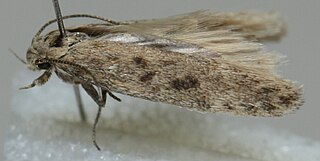
Scrobipalpa obsoletella, the summer groundling, is a moth of the family Gelechiidae. It is found in most of Europe, Turkey, the Caucasus, from Iran to Asian Russia (Transbaikal) and Mongolia. It has also been recorded from New Zealand, South Africa and North America, where it is probably an introduced species. The habitat consists of coastal salt marshes and sandy beaches.

Dolomedes schauinslandi or the Rangatira spider is a large spider of the family Pisauridae. It is only found on South East Island (Rangatira), Houruakopara and Mangere Islands in the Chatham Islands, New Zealand. It is one of New Zealand's largest and rarest spiders.

Haplinis is a genus of South Pacific dwarf spiders that was first described by Eugène Louis Simon in 1894.

Parafroneta is a genus of South Pacific dwarf spiders that was first described by A. D. Blest in 1979.

Waitkera is a genus of spiders in the family Uloboridae. It was first described in 1979 by Opell. As of 2021, it contains only one species, Waitkera waitakerensis, found in New Zealand.

Anoteropsis forsteri is a species of wolf spider that is endemic to New Zealand.

Anoteropsis hilaris, commonly referred as the garden wolf spider or the grey wolf spider, is a species of wolf spider that is endemic to New Zealand.
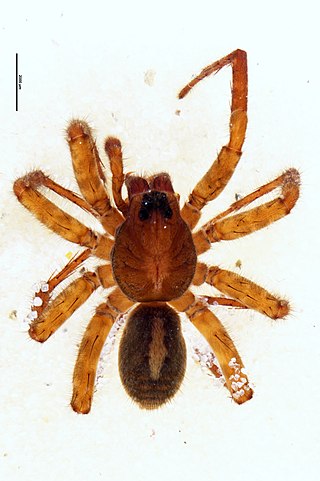
Anoteropsis cantuaria is a species of wolf spider that is endemic to the Canterbury Plains of New Zealand.

The Lincoln University Entomology Research Collection is a collection of approximately 500,000 insect, spider, and other arthropod specimens housed in Lincoln University, New Zealand. One of New Zealand's largest insect research collections, it is the only one based in a university.

Anoteropsis montana is a species of wolf spider endemic to New Zealand. It was first formally named in 2002.



















